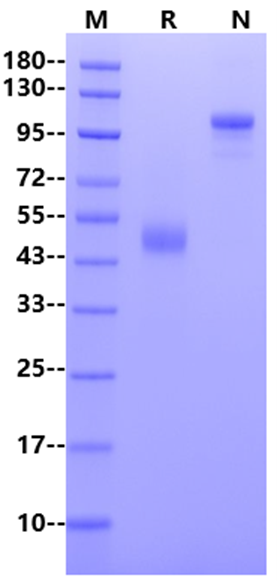Gln24-Pro150, with C-terminal Human IgG1 Fc QDVHQSPRLTIASEGDSVNITCSTRGHLEGILMKKIWPQAYNVIYFEDRQEPTVDRTFSGRINFSGSQKNLTITISSLQLADTGDYTCEAVRKVSARGLFTTVVVKEKSSQEAYRSQEPLQTSFSFPIEGRMDPKSSDKTHTCPPCPAPELLGGPSVFLFPPKPKDTLMISRTPEVTCVVVDVSHEDPEVKFNWYVDGVEVHNAKTKPREEQYNSTYRVVSVLTVLHQDWLNGKEYKCKVSNKALPAPIEKTISKAKGQPREPQVYTLPPSRDELTKNQVSLTCLVKGFYPSDIAVEWESNGQPENNYKTTPPVLDSDGSFFLYSKLTVDKSRWQQGNVFSCSVMHEALHNHYTQKSLSLSPGK
1、Sempowski G D. et al. (1999) Resistance of CD7-deficient mice to lipopolysaccharide-induced shock syndromes. J Exp Med. 189(6): 1011-1016.
CD7 is a 40-kD member of the Ig gene superfamily that is expressed on a major subset of human peripheral T lymphocytes and NK cells. CD7 is an early T cell activation antigen in that CD7 mRNA levels rise within 15 min after initiation of a transmembrane calcium ion flux. CD7 can complex with CD3 and CD45 molecules, and CD7 signaling involves both protein kinase C and protein tyrosine kinase. CD7 has been shown to be a functional signal-transducing molecule on resting NK cells. Antibody cross-linking of NK cell CD7 induced increases in free cytoplasmic calcium, secretion of IFN-γ, NK cell proliferation, adhesion to fibronectin, and NK cytotoxic activity. Although the above studies have demonstrated in vitro roles for CD7 in T and NK cell activation and/or adhesion, relevant functions of CD7 in vivo remain unknown.

Anti-His antibody Immobilized on CM5 Chip captured CD7 Ligand/SECTM1 His Tag, Mouse (Cat. No. UA010323), can bind CD7 Fc Chimera, Mouse (Cat. No. UA010333) with an affinity constant of 31.54nM as determined in SPR assay.
